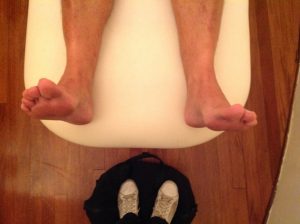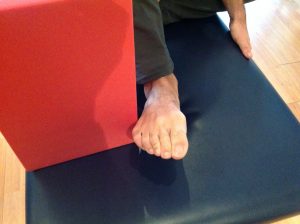
If you’re a runner with tight calves you’ve no doubt been told to stretch and foam roll them. You’ve probably found this has only provided temporary relief however.
In this post we’ll look at the reasons for this and provide a longer term solution.
Let me start by asking you a question.
Do you train the muscles that bring the top of your foot towards your shin? Otherwise known as the ankle dorsiflexors.

If you answered no then you can prepare yourself for a revelation. If you answered yes, pat yourself on the back but read on as this post will give you further options.
There are 5 muscles that cross the ankle and produce dorsiflexion. It’s rare that anybody thinks about training them.
They are (drum roll please)…
Tibialis anterior
Peroneus tertius
Peroneus brevis
Extensor hallucis longus
Extensor digitorum longus
These muscles hold the key to reducing tension in your calves.
Here’s why.
Every time your foot hits the ground, these muscles are required to slow your foot’s descent to the floor, especially if you’re a heel striker.
They then allow your lower leg to move forward over your foot into dorsiflexion. This time with your shin going to meet your foot rather than the other way around.
If your dorsiflexors are weak, your central nervous system may attempt to limit that motion.
How does it do that?
By increasing tension in your calves.
No amount of stretching, massage, foam rolling, or spiky ball action will improve this situation because it does nothing to improve the strength of your dorsiflexors.
Doing these exercises will however.
First decide which side needs more work. In the image below this gentleman’s left ankle is more limited (he can’t bring his left foot back as far as his right).

Then work through the following exercises in this order.

Tibialis anterior isometric.
Curl your toes down and pull your foot straight back towards your shin. Hold for 6 seconds before relaxing. Repeat a further 5 times.

Peroneus tertius isometric.
Curl your toes down and pull your foot back, this time rotate your lower leg out into an immovable object (note a yoga block is not an immovable object). Push for 6 seconds before relaxing. Repeat a further 5 times.

Peroneus brevis isometric.
This time point your ankle and push straight out into an immovable object. Hold 6 seconds and repeat a further 5 times.
Lastly practice bringing your toes off the ground from a standing position to target your toe extensors. Again hold for 6 x 6 secs.
Now check back in with your dorsiflexion.
Did it improve?
Excellent. Use these exercises on a regular basis (2 x a week) for a sustained period (6 – 8 weeks) to make long lasting changes.
For a further post on what tightness in the muscular system represents go here.